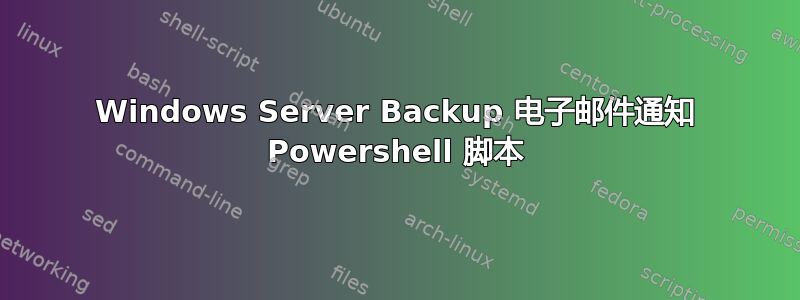
我希望下面的一切都有意义,任何帮助都将不胜感激。
我正在尝试创建一个脚本,该脚本会通知我 Windows Server Backup 是否成功或在服务器列表上失败。
使用任务计划程序将脚本设置为在特定时间运行。如果我使用管理员帐户,脚本可以正常运行。但是,我尝试使用权限有限的用户帐户运行脚本,但失败了。
如果用户帐户属于“事件日志读取器”和“远程管理用户”,则脚本将无法正常运行,并且事件查看器日志中会出现错误 - 事件 ID 1016,来源 DistributedCOM
应用程序特定的权限设置未向用户“我的用户帐户”授予 CLSID 为 {37734C4D-FFA8-4139-9AAC-60FBE55BF3DF} 和 APPID 为 {C3B65D83-FB15-4E3F-BA04-097D1E2B5AC1} 的 COM 服务器应用程序的本地激活权限
但是,如果我将用户帐户添加到“备份操作员”组和“远程管理用户”组,它就可以正常运行。
我有点困惑为什么会发生这种情况。我以为“事件日志读取器”组会让您读取事件 ID。
以下是我的 Poweshell 脚本。我从以下网站获取了该脚本:http://blog.jocha.se/tech/wbadmin-backup-mail-report- 我做了一些改变。
Add-PSSnapin Windows.ServerBackup -ErrorAction SilentlyContinue
#######################################
#-------- Variables to change --------#
$Servers = New-PSSession -Computername server1,server2
Invoke-Command -Session $Servers {
# Set your Company name
$Company = "xxxx"
# Set the recipient/sender email-address
$MailMessageTo = "[email protected]" # List of users to email your report to (separate by comma)
$MailMessageFrom = "[email protected]" # Enter the email you would like the report sent from
$MailMessageSMTPServer = "X.X.X.X" # Enter your own SMTP server DNS name / IP address here
$MailMessagePriority = "Normal" # Low/Normal/High
$HTMLMessageSubject = $env:computername+": Backup Report - "+(Get-Date) # Email Subject
#---- Don't change anything below ----#
#######################################
Try {
$CurrentTime = (Get-Date).ToString("yyyy-MM-dd HH:mm")
$Computer = Get-Content env:computername
$WBJob = Get-WBJob -Previous 1
$WBSummary = Get-WBSummary
$WBLastSuccess = ($WBSummary.LastSuccessfulBackupTime).ToString("yyyy-MM-dd HH:mm")
$WBResult = $WBSummary.LastBackupResultHR
$WBErrorMsg = $WBJob.ErrorDescription + "`n" + $WBSummary.DetailedMessage
$WBStartTime = $WBJob.StartTime
$WBEndTime = $WBJob.EndTime
$WBDuration = (New-TimeSpan -Start $WBStartTime -End $WBEndTime)
#$Password = ConvertTo-SecureString $MailPassword -AsPlainText -Force
#$Credentials = New-Object System.Management.Automation.PSCredential ($MailUser, $Password)
Function FormatBytes
{
Param
(
[System.Int64]$Bytes
)
[string]$BigBytes = ""
#Convert to TB
If ($Bytes -ge 1TB) {$BigBytes = [math]::round($Bytes / 1TB, 2); $BigBytes += " TB"}
#Convert to GB
ElseIf ($Bytes -ge 1GB) {$BigBytes = [math]::round($Bytes / 1GB, 2); $BigBytes += " GB"}
#Convert to MB
ElseIf ($Bytes -ge 1MB) {$BigBytes = [math]::round($Bytes / 1MB, 2); $BigBytes += " MB"}
#Convert to KB
ElseIf ($Bytes -ge 1KB) {$BigBytes = [math]::round($Bytes / 1KB, 2); $BigBytes += " KB"}
#If smaller than 1KB, leave at bytes.
Else {$BigBytes = $Bytes; $BigBytes += " Bytes"}
Return $BigBytes
}
Function Log-BackupItems
{
Param
(
[System.String]$Name,
[System.String]$Status,
[System.Int64]$Bytes
)
$Item = New-Object System.Object;
$Item | Add-Member -Type NoteProperty -Name "Name" -Value $Name;
$Item | Add-Member -Type NoteProperty -Name "Status" -Value $Status;
$Item | Add-Member -Type NoteProperty -Name "Size" -Value (FormatBytes -Bytes $Bytes);
Return $Item;
}
$results=@()
$WBJob | % {
$_.JobItems | % {
$BackupItem = $null
If ($_.Name -eq 'VolumeList') {
$_ | % {$_.SubItemList | % {
$BackupItem = Log-BackupItems -Name $_.Name -Status $_.State -Bytes $_.TotalBytes
$results += $BackupItem
}}
}
Else {
$_ | % {
$BackupItem = Log-BackupItems -Name $_.Name -Status $_.State -Bytes $_.TotalBytes
$results += $BackupItem
}
}
}
}
# Change Result of 0 to Success in green text and any other result as Failure in red text
If ($WBResult -eq 0) { $WBResult = "Successful"}
Else {$WBResult = "Failed"}
# Assemble the HTML Report
$HTMLMessage = @"
<!DOCTYPE html>
<html>
<head>
<title>$Company Backup Report for $Computer</title>
<style>
body { font-family: Verdana, Geneva, Arial, Helvetica, sans-serif; font-size: 12px }
h3{ clear: both; font-size: 150%; margin-left: 20px;margin-top: 30px; }
table { padding: 15px 0 20px; width: 500px; text-align: left; }
td, th { padding: 0 20px 0 0; margin 0; text-align: left; }
th { margin-top: 15px }
a, a:visited { color: #2ea3f2; text-decoration: none; }
#Report { width: 600px; }
#Successful { color: green }
#Failed { color: red }
</style>
</head>
<body>
<div id="Report">
<p><h3><a>$Company Backup Report for $Computer</a></p></h3>
<table id="summary"><tbody>
<tr><td>Todays date:</td>
<td>$CurrentTime</td></tr>
<tr><td>Last Successful Backup:</td>
<td>$WBLastSuccess</td></tr>
<tr><td>Start time last backup:</td>
<td>$WBStartTime</td></tr>
<tr><td>End time last backup:</td>
<td>$WBEndTime</td></tr>
<tr><td>Duration last backup:</td>
<td>$WBDuration</td></tr>
<tr><td>Backup Result:</td>
<td><b id="$WBResult">$WBResult</b></td></tr>
<tr><td>Error Message (if applicable):</td>
<td>$WBErrorMsg</td></tr></tbody></table>
$(
$html = $results | ConvertTo-HTML -Fragment
$xml=[xml]$html
$attr=$xml.CreateAttribute('id')
$attr.Value='items'
$xml.table.Attributes.Append($attr) | out-null
$html=$xml.OuterXml | out-string
$html
)
</div>
</body>
</html>
"@
# Email the report
$MailMessageOptions = @{
From = "$MailMessageFrom"
To = "$MailMessageTo"
Subject = "$WBResult : $HTMLMessageSubject"
BodyAsHTML = $True
Body = "$HTMLMessage"
Priority = "$MailMessagePriority"
SmtpServer = "$MailMessageSMTPServer"
}
Send-MailMessage @MailMessageOptions
}
Catch {
$MailMessageOptions = @{
From = "$MailMessageFrom"
To = "$MailMessageTo"
Subject = "Failed Backup on $Computer"
BodyAsHTML = $True
Body = "The backup script failed to run!"
Priority = "$MailMessagePriority"
SmtpServer = "$MailMessageSMTPServer"
}
Send-MailMessage @MailMessageOptions
}
}
我可能也完全误解了一切:)
答案1
Get-WBJob 通过服务器备份模块访问日志。该模块允许您管理备份作业,因此您需要成为备份操作员才能使用许多(/大多数?/所有?)命令。


